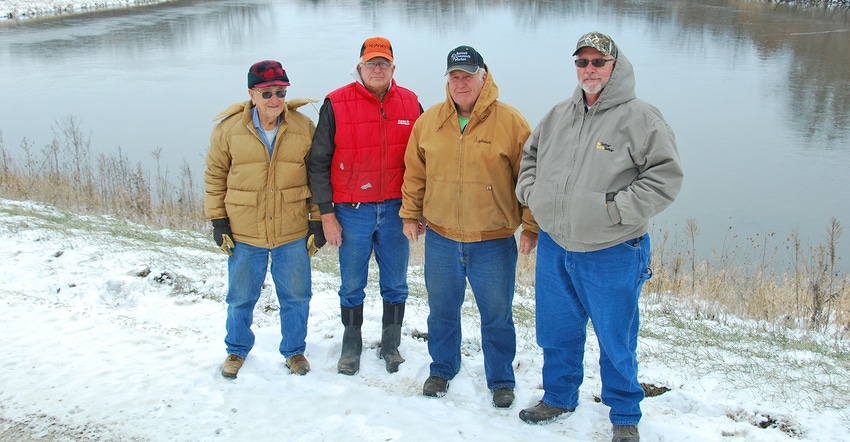January 31, 2019

Sixty years after the first of 1,182 flood-prevention structures were built in Missouri with federal financial and technical assistance, landowners who have witnessed the before-and-after effects of heavy rain are still praising the benefits of the watershed projects.
“Panther Creek used to flood almost every time it rained,” says John Meek, who farms near Ridgeway in Harrison County, “but it hasn’t flooded at all since they put the structures in, including 1993,”.
Twelve structures were constructed in the Panther Creek Watershed in the 1970s. A watershed is a land area that drains to a common point, such as a creek or river. Panther Creek is one of 35 Missouri watershed projects, mostly in northern Missouri, that were planned and at least partially completed by the USDA’s Natural Resources Conservation Service (NRCS). The watershed projects were authorized by the Watershed Protection and Flood Prevention Act (Public Law 566) passed by Congress in 1954.
Congress halted funding for the program in 2010, before all the planned projects could be completed. It later restored some funding in 2017, which is allowing construction of two larger structures in Missouri that will create reservoirs large enough to provide water supply and recreation in addition to flood reduction — the 344-acre Little Otter Creek Reservoir in Caldwell County and the 2,352-acre East Locust Creek Reservoir in Sullivan County.
Three other water supply structures were also built in Missouri before funds dried up in 2010. However, most of Missouri’s watershed structures constructed during the program’s peak years are strategically placed “ponds” with dams designed to capture runoff and hold it back until it is released slowly through a principal spillway pipe in the dam.
“The project goals are not to completely eliminate flooding, but to the reduce the severity of flooding and to lessen the negative economic impact of flooding,” says Marty Comstock, NRCS state conservation engineer. “The estimated annual benefits of the 1,182 structures is $27 million.”
“These structures became part of the rural storm water infrastructure,” adds Clif Baumer, an NRCS environmental engineer in Columbia. “A certain number of them were necessary to have the positive impact we were hoping to achieve. We tried to get 30% of a watershed protected by structures. We knew from the scientific research that they would work, but the best measure we have of their success is mostly anecdotal.”
And the stories poured in from farmers and landowners.
Projects that work
“The biggest problem we had before the structures were installed was flash flooding that destroyed the corn crops,” says Bryan Cox, who farms near Bethany in the West Fork of Big Creek watershed and is a member of the watershed board. “Since the structures went in, everyone has been able to maintain some type of crop rotation without losing a crop every year or two.”
Cox says the positive impact of the watershed structures has been evident in communities as well as on farms.
“Some of the bridges in Harrison County would only last three or four years because of the floodwater washing around the abutments, but the water doesn’t do near the damage as it did before,” he says. “These dams have saved the county a lot of money.”
Flood-damage-reduction structures were designed to last 50-100 years. To reduce sediment accumulation, land treatment practices are applied in the watershed to reduce soil erosion to acceptable levels.
Baumer says that even though some of the oldest structures are nearing the end of their design life, they will provide flood benefits much longer than that.
“That design life was really based on how long we estimated it would take for sediment to fill the reservoir, but they will still function even when they fill in because of the height of the dam above the principal spillway,” he says.
Baumer says the structures provide other benefits as well, such as fishing, wildlife habitat, aesthetics and increased property value. At the request of landowners, livestock-watering tanks could be added to the base of dams. And some structures near roadways were fitted with dry hydrants that allow fire departments to refill tanker trucks without having to drive back to town. That aids in fighting rural fires and can lower homeowner insurance rates.
Upkeep is key
Landowners who have structures located on their property have provided land rights that allow the watershed district to enter the property and maintain the structures. Maintenance usually involves removing trees from dams and clearing clogs in drain pipes.
Gerald Parker, a former Harrison County commissioner who farms near Bethany, says landowners should be willing to maintain the structures because of the benefits they receive from the federally funded structures. When landowners do not maintain the structures themselves, the watershed districts attempt to do so with the aid of property taxes levied for that purpose.
Expanding reach
Bueford Cooper, a 96-year-old farmer at Ridgeway, remembers how bad conditions were in the watershed before the structures were built.
“I had some ditches that were so deep that you wouldn’t dare get down in them and try to get out,” Cooper says. “But I put the structures in and now you can walk across (where the ditches were). It’s beautiful.”
Cooper even added some structures on his own.
“I wanted one on every ditch,” he says. “Sometimes I couldn’t get cost share, but I built them anyway because it helps everyone.”
Steve Starmer, an NRCS civil engineering technician, worked for the agency in Harrison County for 31 years and took an active role in planning many of the 144 structures in West Fork Big Creek Watershed and the 81 structures in East Fork Big Creek Watershed.
“It has been very satisfying for me to work on these projects because they sure have helped,” he says.
Rahm is a public affairs officer with the USDA-NRCS.
About the Author(s)
You May Also Like




